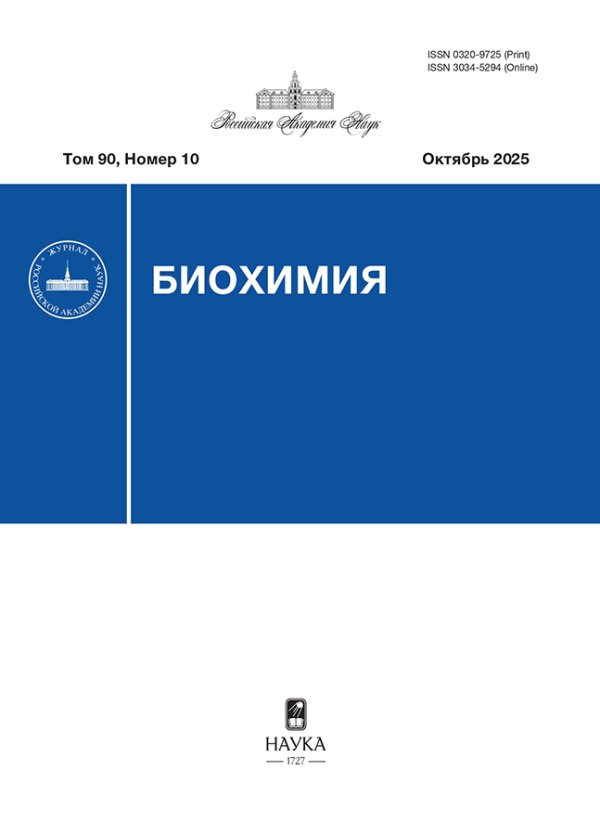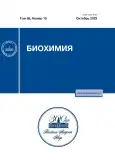Generation of electric potential difference by chromatophores from photosynthetic bacteria in the presence of trehalose under continuous illumination
- Authors: Vitukhnovskaya L.A1,2, Zaspa A.A1, Mamedov M.D1
-
Affiliations:
- Belozersky Institute of Physico-Chemical Biology, Moscow State University
- Semenov Federal Research Center for Chemical Physics, Russian Academy of Sciences
- Issue: Vol 88, No 10 (2023)
- Pages: 1731-1741
- Section: Articles
- URL: https://journals.rcsi.science/0320-9725/article/view/233489
- DOI: https://doi.org/10.31857/S0320972523100020
- EDN: https://elibrary.ru/OSMUJE
- ID: 233489
Cite item
Full Text
Abstract
About the authors
L. A Vitukhnovskaya
Belozersky Institute of Physico-Chemical Biology, Moscow State University;Semenov Federal Research Center for Chemical Physics, Russian Academy of Sciences119992 Moscow, Russia;119991 Moscow, Russia
A. A Zaspa
Belozersky Institute of Physico-Chemical Biology, Moscow State University119992 Moscow, Russia
M. D Mamedov
Belozersky Institute of Physico-Chemical Biology, Moscow State University
Email: mahirmamedov@yandex.ru
119992 Moscow, Russia
References
- Bella, F., Gerbaldi, C., Barolo, C., and Grätzel, M. (2015) Aqueous dye-sensitized solar cells, Chem. Soc. Rev., 44, 3431-3473, doi: 10.1039/c4cs00456f.
- Calió, L., Kazim, S., Grätzel, M., and Ahmad, S. (2016) Hole-transport materials for perovskite solar cells, Angew. Chem. Int. Ed. Engl., 55, 14522-14545, doi: 10.1002/anie.201601757.
- Najafpour, M. M., Renger, G., Hołyńska, M., Moghaddam, A. N., Aro, E. M., et al. (2016) Manganese compounds as water-oxidizing catalysts: from the natural water-oxidizing complex to nanosized manganese oxide structures, Chem. Rev., 116, 2886-2936, doi: 10.1021/acs.chemrev.5b00340.
- Teodor, A. N., and Bruce, B. D. (2020) Putting photosystem I to work: truly green energy, Trends Biotechnol., 38, 1329-1342, doi: 10.1016/j.tibtech.2020.04.004.
- Singharoy, A., Maffeo, C., Delgado-Magnero, K. H., Swainsbury, D. J. K., Sener, M., et al. (2019) Atoms to phenotypes: molecular design principles of cellular energy metabolism, Cell, 179, 1098-1111, doi: 10.1016/j.cell.2019.10.021.
- Crofts, A. R. (2021) The modified Q-cycle: a look back at its development and forward to a functional model, Biochim. Biophys. Acta Bioenerg., 1862, 148417, doi: 10.1016/j.bbabio.2021.148417.
- Crofts, A. R., Meinhardt, S. W., Jones, K. R., and Snozzi, M. (1983) The role of the quinone pool in the cyclic electron-transfer chain of Rhodopseudomonas sphaeroides: a modified Q-cycle mechanism, Biochim. Biophys. Acta, 723, 202-218, doi: 10.1016/0005-2728(83)90120-2.
- Glaser, E. C., and Crofts, A. R. (1984) A new electrogenic step in the ubiquinol: cytochrome c2 oxidoreductase complex of Rhodopseudomonas sphaeroides, Biochim. Biophys. Acta, 766, 322-333, doi: 10.1016/0005-2728(84)90248-2.
- Drachev, L. A., Kaminskaya, O. P., Konstantinov, A. A., Mamedov, M. D., Samuilov, A. Y., et al. (1986) Effects of electron donors and acceptors on the kinetics of the photoelectric responses in Rhodospirillum rubrum and Rhodopseudomonas sphaeroides chromatophores, Biochim. Biophys. Acta, 850, 1-9, doi: 10.1016/0005-2728(86)90002-2.
- Drachev, L. A., Kaurov, B. S., Mamedov, M. D., Mulkidjanian, A. Y., Semenov, A. Y., et al. (1989) Flash-induced electrogenic events in the photosynthetic reaction center and bc1 complexes of Rhodobacter sphaeroides chromatophores, Biochim. Biophys. Acta, 973, 189-197, doi: 10.1016/S0005-2728(89)80421-9.
- Kaminskaya, O. P., and Semenov, A. Yu. (2021) The mechanisms of electrogenic reactions in bacterial photosynthetic reaction centers: Studies in collaboration with Alexander Konstantinov, Biochemistry (Moscow), 86, 1-7, doi: 10.1134/S0006297921010016.
- Ajiki, S., Toyotama, H., Hara, M., and Miyake, J. (1997) Light-induced electrical response of chromatophore film in semi-wet photocell with an agar layer containing an electron mediator, Bioelectrochem. Bioenergetics, 43, 71-75, doi: 10.1016/S0302-4598(96)05177-X.
- Drachev, L. A., Kaulen, A. D., Semenov, A. Yu., Severina, I. I., and Skulachev, V. P. (1979) Lipid-impregnated filters as a tool for studying the electric current-generating proteins, Anal. Biochem., 96, 250-262, doi: 10.1016/0003-2697(79)90580-3.
- Drachev, L. A., Mamedov, M. D., and Semenov, A. Y. (1987) The antimycin-sensitive electrogenesis in Rhodobacter sphaeroides chromatophores, FEBS Lett., 213, 128-132, doi: 10.1016/0014-5793(87)81477-1.
- Seibert, M., and Kendall-Tobais, M. W. (1982) Photoelectrochemical properties of electrodes coated with photoactive-membrane vesicles isolated from photosynthetic bacteria, Biochim. Biophys. Acta, 681, 504-511, doi: 10.1016/0005-2728(82)90193-1.
- Hara, M., Ajiki, S., and Miyake, J. (1998) Topological characterization and immobilization of a chromatophore membrane from Rhodopseudomonas viridis for application as a photoelectrical device, Science, 5, 717-721, doi: 10.1016/S0968-5677(98)00111-4.
- Magis, G. J., Hollander, M.-J., Onderwaater, W. G., Olsen, J. D., Hunter, C. N., et al. (2010) Light harvesting, energy transfer and electron cycling of a native photosynthetic membrane adsorbed onto a gold surface, Biochim. Biophys. Acta, 1798, 637-645, doi: 10.1016/j.bbamem.2009.12.018.
- Woronowicz, K., Ahmed, S., Biradar, A. A., Biradar, A. V., Birnie, D. P., et al. (2012) Near-IR absorbing solar cell sensitized with bacterial photosynthetic membranes, Photochem. Photobiol., 88, 1467-1472, doi: 10.1111/j.1751-1097.2012.01190.x.
- Harrold, J. W., Woronowicz, K., Lamptey, J., Baird, J., Moshar, A., et al. (2013) Functional interfacing of Rhodospirillum rubrum chromatophores to a conducting support for capture and conversion of solar energy, J. Phys. Chem. B, 117, 11249-11259, doi: 10.1021/jp402108s.
- Vitukhnovskaya, L. A., Zaspa, A. A., Semenov, A. Yu., and Mamedov, M. D. (2023) Conversion of light into electricity in a semi-synthetic system based on photosynthetic bacterial chromatophores, Biochim. Biophys. Acta Bioenerg., 1864, 148975, doi: 10.1016/j.bbabio.2023.148975.
- Ormerod, J. G., Ormerod, K. S., and Gest, H. (1961) Light-dependent utilization of organic compounds and photoproduction of molecular hydrogen by photosynthetic bacteria; Relationships with nitrogen metabolism, Arch. Biochem. Biophys., 94, 449-463, doi: 10.1016/0003-9861(61)90073-x.
- Woronowicz, K., Sha, D., Frese, R. N., and Niederman, R. A. (2011) The accumulation of the light-harvesting 2 complex during remodeling of the Rhodobacter sphaeroides intracytoplasmic membrane results in a slowing of the electron transfer turnover rate of photochemical reaction centers, Biochemistry, 50, 4819-4829, doi: 10.1021/bi101667e.
- Clayton, R. K. (1966) Spectroscopic analysis of bacteriochlorophylls in vitro and in vivo, Photochem. Photobiol., 5, 669-677, doi: 10.1111/j.1751-1097.1966.tb05813.x.
- Garcia, A. F., Venturoli, G., Gad'on, N., Fernandez-Velasco, J. G., Melandri, B. A., and Drews, G. (1987) The adaptation of the electron transfer of Rhodopseudomonas capsulata to different light intensities, Biochim. Biophys. Acta, 890, 335-345, doi: 10.1016/0005-2728(87)90161-7.
- Dutton, P. L., Petty, K. M., Bonner, H. S., and Morse, S. D. (1975) Cytochrome c2 and reaction center of Rhodopseudomonas sphaeroides Ga. membranes. Extinction coefficients, content, half-reduction potentials, kinetics and electric field alterations, Biochim. Biophys. Acta, 387, 536-556, doi: 10.1016/0005-2728(75)90092-4.
- Altamura, E., Albanese, P., Marotta, R., Milano, F., Fiore, M., et al. (2021) Chromatophores efficiently promote light-driven ATP synthesis and DNA transcription inside hybrid multicompartment artificial cells, Proc. Natl. Acad. Sci. USA, 118, e2012170118, doi: 10.1073/pnas.2012170118.
- Palazzo, G., Mallardi, A., Giustini, M., Monica, M. D., and Venturoli, G. (2000) Interactions of photosynthetic reaction center with 2,3-dimethoxy-5-methyl-1,4-benzoquinone in reverse micelles, Phys. Chem. Chem. Phys., 20, 4624-4629, doi: 10.1039/b003905p.
- Friebe, V. M., Swainsbury, D. J. K., Fyfe, P. K., Heijden, W. V. D., Jones, M. R., and Frese, R. N. (2016) On the mechanism of ubiquinone mediated photocurrent generation by a reaction center based photocathode, Biochim. Biophys. Acta Bioenerg., 1857, 1925-1934, doi: 10.1016/j.bbabio.2016.09.011.
- Yaghoubi, H., Li, Z., Jun, D., Saer, R., and Slota, J. E. (2012) The role of gold-adsorbed photosynthetic reaction centers and redox mediators in the charge transfer and photocurrent generation in a bio-photoelectrochemical cell, J. Phys. Chem. C, 116, 24868-24877, doi: 10.1021/jp306798p.
- Zdarta, J., Meyer, A. S., Jesionowski, T., and Pinelo, M. (2018) A general overview of support materials for enzyme immobilization. Characteristics, properties, practical utility, Catalysts, 8, 92, doi: 10.3390/catal8020092.
- Imam, H. T., Marr, P. C., and Marr, A. C. (2021) Enzyme entrapment, biocatalyst immobilization without covalent attachment, Green Chem., 23, 4980-5005, doi: 10.1039/D1GC01852C.
- Grattieri, M., Rhodes, Z., Hickey, D. P., Beaver, K., and Minteer, S. D. (2019) Understanding biophotocurrent generation in photosynthetic purple bacteria, ACS Catal., 9, 867-873, doi: 10.1021/acscatal.8b04464.
- Zaspa, A. A., Vitukhnovskaya, L. A., Mamedova, A. M., Semenov, A. Y., and Mamedov, M. D. (2020) Photovoltage generation by photosystem II core complexes immobilized onto a Millipore filter on an indium tin oxide electrode, J. Bioenerg. Biomembr., 52, 495-504, doi: 10.1007/s10863-020-09857-1.
- Zaspa, A., Vitukhnovskaya, L., Mamedova, A., Allakhverdiev, S. I., Semenov, A., and Mamedov, M. D. (2022) Voltage generation by photosystem I complexes immobilized onto a millipore filter under continuous illumination, Int. J. Hydrogen Energy, 47, 11528-11538, doi: 10.1016/j.ijhydene.2022.01.175.
- Jackson, J. B., and Crofts, A. R. (1971) The kinetics of light induced carotenoid changes in rhodopseudomonas spheroides and their relation to electrical field generation across the chromatophore membrane, Eur. J. Biochem., 18, 120-130, doi: 10.1111/j.1432-1033.1971.tb01222.x.
- Michels, P., Hellingwerf, K. J., Lolkema, J. S., Friedberg, I., Konings, W. N. (1981) Effects of the medium composition on the components of the electrochemical proton gradient in Rhodopseudomonas sphaeroides, Arch. Microbiol., 130, 357-361, doi: 10.1007/BF00414600.
- Mamedov, M. D., Nosikova, E. S., Vitukhnovskaya, L. A., Zaspa, A. A., and Semenov, A. Yu. (2018) Influence of the disaccharide trehalose on the oxidizing side of photosystem II, Photosynthetica, 56, 236-243, doi: 10.1007/s11099-017-0750-z.
- Mobius, K., Savitsky, A., Malferrari, M., Francia, F., Mamedov, M., et al. (2020) Soft dynamic confinement of membrane proteins by dehydrated trehalose matrices: high-field EPR and fast-laser studies, Appl. Magn. Reson., 50, 773-850, doi: 10.1007/s00723020-01240-y.
- Simongini, M., Puglisi, A., Genovese, F., and Hochkoeppler, H. (2023) Trehalose counteracts the dissociation of tetrameric rabbit lactate dehydrogenase induced by acidic pH conditions, Arch. Biochem. Biophys., 740, 109584, doi: 10.1016/j.abb.2023.109584.
- Tang, M., Waring, A. J., and Hong, M. (2007) Trehalose-protected lipid membranes for determining membrane protein structure and insertion, J. Magn. Reson., 184, 222-227, doi: 10.1016/j.jmr.2006.10.006.
- De Moura Torquato, L. D., and Grattieri, M. (2022) Photobioelectrochemistry of intact photosynthetic bacteria: advances and future outlook, Curr. Opin. Electrochem., 34, 101018, doi: 10.1016/j.coelec.2022.101018.
Supplementary files










